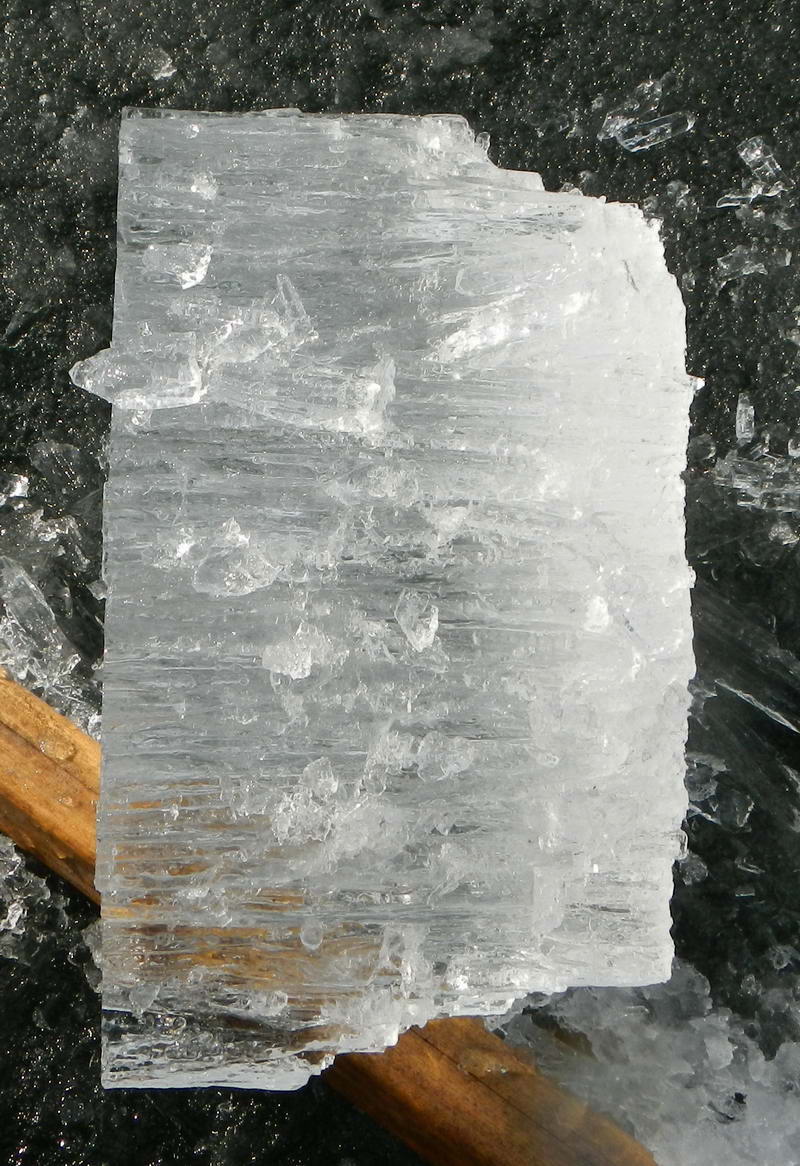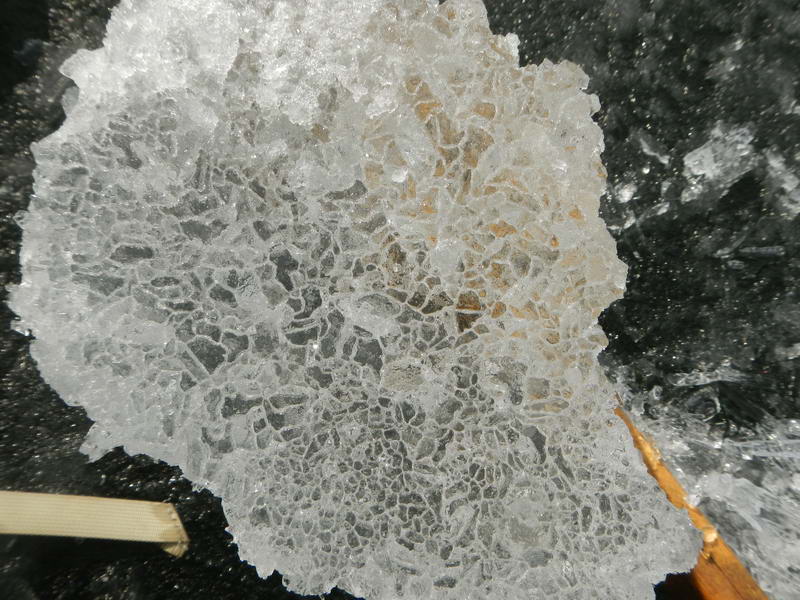Candled Ice
 Side veiw of 7" thick candled ice (late in thaw stage 4).
Side veiw of 7" thick candled ice (late in thaw stage 4).
 Top view of the same ice. The white strap on the left side is 3/4" wide.
Top view of the same ice. The white strap on the left side is 3/4" wide.
The two main types of black ice are S1 and S2. S1 has large crystals with sizes that range from an inch up to several feet. Typical crystals are a few inches to a foot. S2 ice has average crystal sizes that range from 0.04" up to an inch. Typical sizes of S2 crystals at the top surface range between 1/8" to 1/2". These crystals have a columnar, vertical arrangement in the ice sheet which look a bit like candles, hence the name 'candled ice'.
Candled ice is the source of many swims, particularly in the spring. Thawed S2 ice is often mixed with stronger S1 ice creating many small areas of weak ice (see picture below). In other situations there can be very large areas of S2 ice and the whole ice sheet can go from strong enough (stage 5) to not strong enough (stage 6) in an hour or less. Ice that is in this state is not ice you should be on unless you want to fall through.
We have also seen situations where two areas of S2 ice had distinctly different strength with the same thaw history. When the following videos were taken the east side of Shelburne Bay (VT) had 14" ice with 1/2-3/4"(a little bigger than the video ice) crystal size but it was much stronger (albeit still very weak compaired to cold ice).
The Thaw Process
Any cold, fully saturated, fresh water ice breaks with relatively little regard to the crystal size or shape. When ice starts to thaw the crystal boundaries start to melt early in the process. Boundaries become the weakest part of the ice. When S2 ice breaks in a thawed state the rod/candle like structure becomes obvious. S2 ice weakens considerably more than S1 ice in a given number of thaw degree days. (Click here for more on thawed ice)
In the Rotten Candled Ice video the ice is 13-1/2" thick. If it were cold it would support a 9000 lb vehicle with a 3:1 safety margin (27,000 lb calculated breakthrough strength). After 103 thaw degree days since the last sustained cold period it is easy to find places that will not support 180 lbs (thaw stage 6). This ice can settle a few tenths of an inch when stepped on as the crystals move from the weight. When you feet punch through, the hole is small which helps slow the plunge and makes it easy to catch yourself on the way down. You may be able lean or twist to the side or catch yourself on your rump, hip or upper leg. At least on this day, it was easy to avoid falling through above your shoulders. Given the small hole you make falling through it would be bad news if you ended up under the ice.
Many of the breakthroughs are only a single foot. For the most part, getting back on the ice is easy (especially with a dry suit and life preserver). It was possible to kneel and even stand in many places. We found a little stage 7 ice (it is shown in the last video clip).
Click here for the second rotten candled ice video: same ice-different guy.
White corn ice can make weak fine grained ice hard to spot:
This highly thawed ice (stages 5 and 6) has a fairly uniform layer of white corn ice on its surface. This hides the underlying ice. A test pole is the only good way to find stage 6 ice. The red arrow points to where the author fell part way through when using the 'body weight test method' (ie, I was not using the test pole enough).
Rotten candled ice is especially tricky when it is cold enough at night to set up a little overnight ice. That lets you get out on ice that feels strong until the sun rethaws the overnight ice. There were several fisherman fatalities in 2013 that occurred on rotten ice. It appears they got on the ice while it felt reasonably firm in the morning and stayed out too long on a warm day.
The term 'rotten candled ice' is intended to mean type S2 ice that is so weak that it just barely supports a person on foot (thaw stage 5) or so weak it will not support a person on foot (thaw stage 6) or not support a prone person trying to get back on the ice after falling through (thaw stage 7). It is important to remember that the thaw stages are based on the ice's ability to support body weight which, in the case of rotten candled ice, has relatively little to do with thickness. 14" ice in stage 6 is significantly more thawed than 5" ice at stage 6. This also suggests that ice thickness ceases to be a useful estimate of strength in thaw conditions, especially with S2 ice. 13.5" stage 6 ice is 120 times weaker than cold S2 ice.
The specific strength of cold S2 ice is about 150 psi flexural strength. In thaw stage 6 it fails by vertical shear failure and has a shear strength of about 0.3 psi. In stage 7 it can get to 0.1 psi or less. Flexural strength is proportional to the square of the thickness. Shear strength is directly proportional to thickness (doubling the thickness doubles the strength for candled ice but quadruples the strength for cold ice).
The bottom line is you should be wary of S2 (small grain size) ice anytime it is above freezing and you should stay off the ice in a more prolonged thaw.
Something else we figured out about well thawed S2 ice is t that hat you definity do NOT want to have an automatic inflatable life jacket on. When you fall through it is likely the lifejacket inflate while your chest is in the hole you just punched out. The inflation pressure of the partially inflated lifejacket appears to be well in excess of what will prevent you from inhaling and the only way you will get free is to deflate the lifejacket.
Bob
